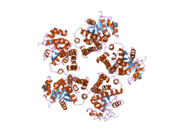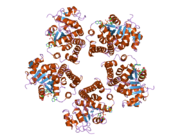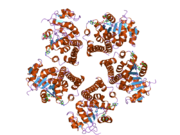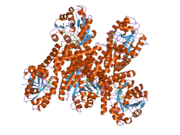
A | B | C | D | E | F | G | H | CH | I | J | K | L | M | N | O | P | Q | R | S | T | U | V | W | X | Y | Z | 0 | 1 | 2 | 3 | 4 | 5 | 6 | 7 | 8 | 9
| PYCR1 | |||||||||||||||||||||||||||||||||||||||||||||||||||
|---|---|---|---|---|---|---|---|---|---|---|---|---|---|---|---|---|---|---|---|---|---|---|---|---|---|---|---|---|---|---|---|---|---|---|---|---|---|---|---|---|---|---|---|---|---|---|---|---|---|---|---|
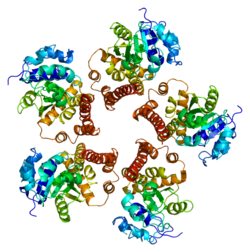 | |||||||||||||||||||||||||||||||||||||||||||||||||||
| |||||||||||||||||||||||||||||||||||||||||||||||||||
| Identifiers | |||||||||||||||||||||||||||||||||||||||||||||||||||
| Aliases | PYCR1, ARCL2B, ARCL3B, P5C, P5CR, PIG45, PP222, PRO3, PYCR, pyrroline-5-carboxylate reductase 1 | ||||||||||||||||||||||||||||||||||||||||||||||||||
| External IDs | OMIM: 179035; MGI: 2384795; HomoloGene: 56002; GeneCards: PYCR1; OMA:PYCR1 - orthologs | ||||||||||||||||||||||||||||||||||||||||||||||||||
| |||||||||||||||||||||||||||||||||||||||||||||||||||
| |||||||||||||||||||||||||||||||||||||||||||||||||||
| |||||||||||||||||||||||||||||||||||||||||||||||||||
| |||||||||||||||||||||||||||||||||||||||||||||||||||
| |||||||||||||||||||||||||||||||||||||||||||||||||||
| Wikidata | |||||||||||||||||||||||||||||||||||||||||||||||||||
| |||||||||||||||||||||||||||||||||||||||||||||||||||
Pyrroline-5-carboxylate reductase 1, mitochondrial is an enzyme that in humans is encoded by the PYCR1 gene.[5][6]
This gene encodes an enzyme that catalyzes the NAD(P)H-dependent conversion of pyrroline-5-carboxylate to proline. This enzyme may also play a physiologic role in the generation of NADP(+) in some cell types. The protein forms a homopolymer and localizes to the mitochondrion. Alternate splicing results in two transcript variants encoding different isoforms.[6] As reported by Bruno Reversade and colleagues, PYCR1 deficiency in humans causes a progeroid disease known as De Barsy Syndrome mainly affecting connective tissues with dermis thinning and bone fragility.[7]
References
- ^ a b c GRCh38: Ensembl release 89: ENSG00000183010 – Ensembl, May 2017
- ^ a b c GRCm38: Ensembl release 89: ENSMUSG00000025140 – Ensembl, May 2017
- ^ "Human PubMed Reference:". National Center for Biotechnology Information, U.S. National Library of Medicine.
- ^ "Mouse PubMed Reference:". National Center for Biotechnology Information, U.S. National Library of Medicine.
- ^ Dougherty KM, Brandriss MC, Valle D (January 1992). "Cloning human pyrroline-5-carboxylate reductase cDNA by complementation in Saccharomyces cerevisiae". The Journal of Biological Chemistry. 267 (2): 871–5. doi:10.1016/S0021-9258(18)48364-0. PMID 1730675.
- ^ a b "Entrez Gene: PYCR1 pyrroline-5-carboxylate reductase 1".
- ^ Reversade B, Escande-Beillard N, Dimopoulou A, Fischer B, Chng SC, Li Y, et al. (September 2009). "Mutations in PYCR1 cause cutis laxa with progeroid features". Nature Genetics. 41 (9): 1016–21. doi:10.1038/ng.413. PMID 19648921. S2CID 10221927.
Further reading
- Herzfeld A, Legg MA, Greengard O (September 1978). "Human colon tumors: enzymic and histological characteristics". Cancer. 42 (3): 1280–3. doi:10.1002/1097-0142(197809)42:3<1280::AID-CNCR2820420337>3.0.CO;2-P. PMID 212173. S2CID 38290701.
- Merrill MJ, Yeh GC, Phang JM (June 1989). "Purified human erythrocyte pyrroline-5-carboxylate reductase. Preferential oxidation of NADPH". The Journal of Biological Chemistry. 264 (16): 9352–8. doi:10.1016/S0021-9258(18)60538-1. PMID 2722838.
- Yeh GC, Roth EF, Phang JM, Harris SC, Nagel RL, Rinaldi A (May 1984). "The effect of pyrroline-5-carboxylic acid on nucleotide metabolism in erythrocytes from normal and glucose-6-phosphate dehydrogenase-deficient subjects". The Journal of Biological Chemistry. 259 (9): 5454–8. doi:10.1016/S0021-9258(18)91032-X. PMID 6201483.
- Herzfeld A, Greengard O (November 1980). "Enzyme activities in human fetal and neoplastic tissues". Cancer. 46 (9): 2047–54. doi:10.1002/1097-0142(19801101)46:9<2047::AID-CNCR2820460924>3.0.CO;2-Q. PMID 6253048.
- Yeh GC, Harris SC, Phang JM (April 1981). "Pyrroline-5-carboxylate reductase in human erythrocytes". The Journal of Clinical Investigation. 67 (4): 1042–6. doi:10.1172/JCI110115. PMC 370662. PMID 6894153.
- Maruyama K, Sugano S (January 1994). "Oligo-capping: a simple method to replace the cap structure of eukaryotic mRNAs with oligoribonucleotides". Gene. 138 (1–2): 171–4. doi:10.1016/0378-1119(94)90802-8. PMID 8125298.
- Basch JJ, Wickham ED, Farrell HM (August 1996). "Pyrroline-5-carboxylate reductase in lactating bovine mammary glands". Journal of Dairy Science. 79 (8): 1361–8. doi:10.3168/jds.S0022-0302(96)76493-7. PMID 8880459.
- Suzuki Y, Yoshitomo-Nakagawa K, Maruyama K, Suyama A, Sugano S (October 1997). "Construction and characterization of a full length-enriched and a 5'-end-enriched cDNA library". Gene. 200 (1–2): 149–56. doi:10.1016/S0378-1119(97)00411-3. PMID 9373149.
- Meng Z, Lou Z, Liu Z, Li M, Zhao X, Bartlam M, Rao Z (June 2006). "Crystal structure of human pyrroline-5-carboxylate reductase". Journal of Molecular Biology. 359 (5): 1364–77. doi:10.1016/j.jmb.2006.04.053. PMID 16730026.
External links
- PDBe-KB provides an overview of all the structure information available in the PDB for Human Pyrroline-5-carboxylate reductase 1, mitochondrial (PYCR1)
Text je dostupný za podmienok Creative Commons Attribution/Share-Alike License 3.0 Unported; prípadne za ďalších podmienok. Podrobnejšie informácie nájdete na stránke Podmienky použitia.
Antropológia
Aplikované vedy
Bibliometria
Dejiny vedy
Encyklopédie
Filozofia vedy
Forenzné vedy
Humanitné vedy
Knižničná veda
Kryogenika
Kryptológia
Kulturológia
Literárna veda
Medzidisciplinárne oblasti
Metódy kvantitatívnej analýzy
Metavedy
Metodika
Text je dostupný za podmienok Creative
Commons Attribution/Share-Alike License 3.0 Unported; prípadne za ďalších
podmienok.
Podrobnejšie informácie nájdete na stránke Podmienky
použitia.
www.astronomia.sk | www.biologia.sk | www.botanika.sk | www.dejiny.sk | www.economy.sk | www.elektrotechnika.sk | www.estetika.sk | www.farmakologia.sk | www.filozofia.sk | Fyzika | www.futurologia.sk | www.genetika.sk | www.chemia.sk | www.lingvistika.sk | www.politologia.sk | www.psychologia.sk | www.sexuologia.sk | www.sociologia.sk | www.veda.sk I www.zoologia.sk






